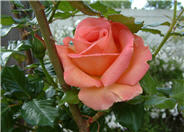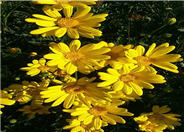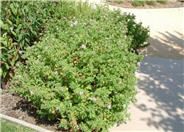
Common name:Hybrid Tea Rose (selections)
Botanical name:Rosa Hybrid Tea varieties
These shrubs and vines are the most loved in the Western USA and are very resilient. They come in a wide variety of sizes and colors and are easy to maintain with proper care. They can be used in a water-conserving garden with careful attention to irrigation practices.

Common name:Euryops
Botanical name:Euryops pectinatus
As a small perennial shrub with 2" wide, bright yellow, daisy-like flowers, blooms on this plant are seen seen almost year round. Its leaves are gray green in color. 'Viridis' is a variety with deep green foliage.

Common name:English Ivy
Botanical name:Hedera helix
This evergreen vine has dark green leaves with pale green veins. When mature, clusters of small green flowers will bloom followed by black berries.

Common name:Giant Bird Of Paradise
Botanical name:Strelitzia nicolai
This clumping evergreen perennial can reach 25' tall fairly quickly, forming a false trunk from the base of the leaves. The leaves are shaped like bananas, reaching 10' long with the widest part reaching 5' . It does best with fertilizer once a month and rich soil. It does not like wet feet so water only when dry. It can be planted in full sun but will do better if it receives afternoon shade. The flowers can reach a size of 10"-12", but plants need to be a few years old before they will flower.

Common name:Garden Geranium
Botanical name:Pelargonium X hortorum
Pelargonium X hortorum is a shrubby, succulent perennial stemmed to 3' or more. Round or kidney-shaped leaves are velvety and hairy, soft to the touch, aromatic, with edges distinctly lobed and scalloped toothed. Single and double flowers are flatter and smaller than those of Pelargonium domesticum variety, but clusters bear more blossoms.
| Designer: Rama Nayeri | Nayeri A 17 |
Photographer: GardenSoft |
Soils and Compost:
Maintain a two to four inch layer of mulch on the soil surface to reduce weeds, infiltrate rain water, and reduce compaction.
Water Saving Tip:
Modify your controller each season. In the rainy season turn it off.
Integrated Pest Management:
Drip and other smart irrigation delivers water directly to roots, allowing no excess water for weeds.
